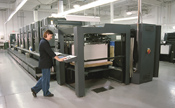
|
|
A look at process control methods for manufacturing
 The process control methods in manufacturing can help a business to better the process in which certain products are manufactured.Take a look at the process control methods that are being used for manufacturing today.These process control methods allow a business to evaluate the process and then make a plan or new design that can help to improve the process.
The process control methods in manufacturing can help a business to better the process in which certain products are manufactured.Take a look at the process control methods that are being used for manufacturing today.These process control methods allow a business to evaluate the process and then make a plan or new design that can help to improve the process.
|
|
The main goal with process control is to get the end product better.Better end products many include the product itself being better or the process becoming more efficient so that there is a greater profit margin with the manufacturing of the product.
When a business is monitoring the process to gain more control, they will need to look at the main part of the process as well as the different parts throughout the process.There will need to be samples taken of the end product with the varying end results, to see what is a better method for process control in manufacturing the products.This is usually most helpful for a business to reduce the output errors and the variances in the end product.
Here is a look at the process control methods used for manufacturing. To start with, look at the basic controller, which starts with measuring the unit.This needs to be done with the right tool, like a temperature transmitter or a pressure transmitter, this is so it can measure the state of process. Then there needs to be an input set point device to set the desired value.This is done in conjunction with the comparator stage.The comparator stage is for comparing the measured value with the set point, and then calculating the difference or error between the two.Third there will then be a control unit that will calculate the output magnitude and direction so that compensation can be made from the desired value.Finely there is the output station that will convert the output from the controller to an actual physical action, like a control valve or a motor.
There are controller units that are used during the control stage.There are proportional controller (P-Controller), integral controller (I-Controller), and derivative controller (D-Controller).Businesses can use one of these controller units for helping them as they look at the process control methods of manufacturing.
The most common used is proportional controller.This is the output action that is proportional to the deviation that was made between the set point and the measured process value. The proportional controller will reduce the rise time, but will never eliminate the steady state of error.
Then there is the integral controller, this is when the controller output is proportional to the amount of time the error is present.Integral controller eliminates the offset.Integral controller will eliminate the steady state of error, but may be unstable.
The derivative controller is where the output is proportional to the rate of change of measurement or error.The derivative controller is not used alone, but it can increase the stability of the system, reducing the overshot and improving the transient response.
When looking at the process control methods for manufacturing, it is possible to use the proportional, integral and derivative controllers together (PID-Controller).By using the three together, it is possible to make a system that can respond quickly to change, derivative, track-required positions, proportional, and reduce steady state of error, integral.
A look at the process control methods will take you into a basic controller.Using this basic idea, different controllers can be used to achieve the highest amount of process control for manufacturing.Use proportional controllers, integral controllers or derivative controllers together or separately.They can help a business to improve process control for manufacturing.
Privacy Policy, Terms of Use